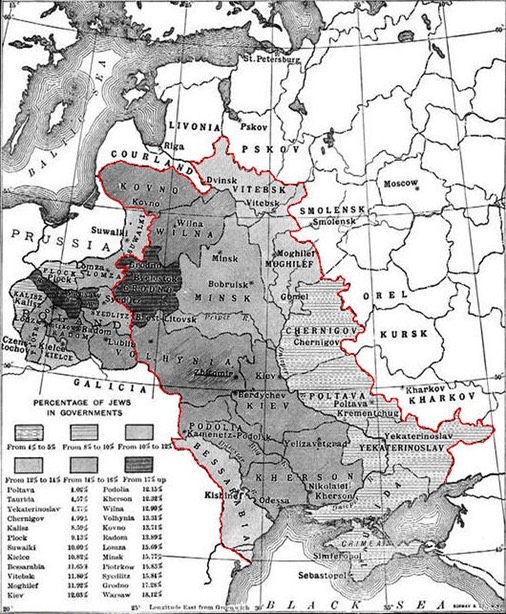Under the Tsars

The quality of Jewish life under the Tsars fluctuated during the alternating periods of reform and reaction that characterized Late Imperial Russia. The Tsars varied in their use of the 'carrot and stick' but the overarching aim of Imperial policy was, as historian Simon Dubnov described it, the 'de-Judaization' of the population.
For example, Tsar Alexander I (r. 1801 - 1825) gave Jews access to Russian schools and universities in the hope of persuading them to assimilate; his successor, Tsar Nicholas I (r. 1825 - 1855), adopted punitive measures, instituting a compulsory 25-year term of military service for Jews (1827) in which boys as young as 8 were forcibly conscripted and placed in "Cantonist"schools. Tsar Alexander II (r. 1855 -1881), known as the "Tsar Liberator", offered incentives, such as allowing Jews to travel, study and live outside the Pale of Settlement; his successor, Tsar Alexander III (1881 - 1894) "waged a fourteen-year war against the Jews" according to Dubnov. In the last decades of the 19th century, spurred by this persecution, immigration to Palestine, Western Europe and the U.S. began in earnest.
What was Byerazino like, in the last years of the 19th century? The Russian census of 1897 documents its evolution from a tiny backwater to a prosperous town with a well-established Jewish community. Out of a total population of 4,987 persons, 3,377 were Jewish. The census mentions a synagogue, six Jewish ‘houses of prayer’, a public trade school, a chemist’s shop, a post and telegraph office, 48 shops, a liquor distillery, a rope-making factory and a mill. Trade fairs were held annually, and markets occurred weekly. The docks on the riverside provided employment, and merchants dealt in timber, tar, turpentine hemp, salt and grain. Steamships carried passengers up and down the river, from Borisov to Bobruisk. The town had a well-known Yeshiva, whose reputation attracted scholars from near and far. Its students included Shmarya Levin, who became a famous Zionist, orator, and teacher, Shmuel Niger, the prominent Yiddish author, literary critic and historian, and Leivick Halpern, the poliical activist, poet and playwright. Family stories collected on this KehilaLink confirm the impression that Byerazino was a decent place to live. But all this was soon to change.
Pahost, although a bit of a backwater in comparison, also boasted a flourishing Jewish population. The majority of the 800 Jews who lived there in 1897 were engaged in the lumber trade, working in the forests owned by the local nobility - the Potocki family. As early as 1835, the community built a large, beautiful synagogue, whose unusual carved decorations were still being admired as late as 1925, when they were described in a Belarusian journal called “Our Land.” By the end of the century there were three synagogues in the town.
The reign of Nicholas II (r. 1894 -1917), the last Romanov ruler, was characterized by war, social upheaval and economic collapse. In Byerazino, as in other parts of the Empire, demonstrations aimed at ending the Tsars' autocratic regime took place, increasing in intensity after Russia’s humiliating defeat in the Russo-Japanese War of 1904-05. Professor Emanuel G. Joffe (b. 1939 in Beresin), a prominent Belarusian political scientist and educator, provides a detailed description of strikes and protest marches in Byerazino that began in 1901 and continued through 1906. On at least one occasion, in March 1905, the governor of Minsk sent soldiers into Byerazino , where they “suppressed dissent” with indiscriminate violence. Dora Perress, who was then 11 years old, remembered being chased by a Cossack, who wounded her with his lead-tipped leather whip.
The Tsar's abdication and the Russian Revolution(s) of 1917 promised new civil rights for Jews. But if an individual's social class or adherence to religious practice clashed with Bolshevik ideology, punishment was savage. The social instability, together with four wars (Crimean, WWI, Russian Civil and Polish-Soviet), two waves of pogroms, and countless attacks by irregular forces and bandits, made the first decades of the 20th century a terribly dangerous time for the Jews of Eastern Europe.
Sources and Additional Reading
Dubnov, Simon. 1920. The History of the Jews of Russia and Poland from the Earliest Times Until the Present Day - In Three Volumes. (Translated from the Russian by I. Friedlaender). Philadelphia: The Jewish Publication Society of America.
Vol. I From the Beginnings Until the Death of Alexander I (1825). Accessed 19 March 2016. https://archive.org/details/historyjewsinru00unkngoog
Vol. II From the Death of Alexander I until the Death of Alexander III (1825 -1894). Accessed 19 March 2016. https://archive.org/details/historyjewsinru02unkngoog
Vol. III From the Accession of Nicholas II Until the Present Day (1916) with Bibliography and Index. Accessed 19 March 2016. https://archive.org/details/historyjewsinru01unkngoog
Joffe, Emanuel G. 2009. "Berezino - Typical Shtetl." English translation by C. Murray Seegert and J. Sverzhinsky.
Joffe, Emanuel G. 2009. "Типичное Местечко” (Typical Shtetl). My Shtetl, The Voice of Jewish Settlements in Belarus. Accessed 2 April 2018. http://shtetle.com/shtetls_minsk/berezino/ioffe.html
"H. Leivick (Leivick Halpern). Lives in the Yiddish Theatre.” The Museum of Family History. Accessed 19 March, 2016 http://www.museumoffamilyhistory.com/yt/lex/L/leivick-h.htm
Levin, Schmarya. 1967. Forward From Exile- The Autobiography of Shmarya Levin. Translated and edited by Maurice Samuel. Philadelphia:The Jewish Publication Society of America
Lokotko, A.I., Knyazeva, O.N., Morozov, E.V., Isotova, O.V. 2013. Tourist Mosaic of Belarus. Minsk: The National Academy of Sciences Belarus. https://books.google.de/books/about/Tourist_Mosaic_of_Belarus.html?id=dNhkBAAAQBAJ&redir_esc=y
Moseley, Marcus. 2010. "Niger, Shmuel." YIVO Encyclopedia of Jews in Eastern Europe. Accessed 20 March 2016. http://www.yivoencyclopedia.org/article.aspx/Niger_Shmuel
Petrovsky-Shtern, Yohanan. 2010. "Military Service in Russia." YIVO Encyclopedia of Jews in Eastern Europe. Accessed 4 March 2016. http://www.yivoencyclopedia.org/article.aspx/Military_Service_in_Russia
Sinilo, Anatoly. 2009. "ПАГОСТ – ДАЎНЕЙШАЕ МЯСТЭЧКА" (Pogost - The Old Town). My Shtetl, The Voice of Jewish Settlements in Belarus. Accessed 2 April 2018. http://shtetle.com/shtetls_minsk/pogost_ber/pogost.html
Sinilo, Anatoly. 2009. "The Old Town of Pogost (1925)". English translation by C. Murray-Seegert and Elizabeth Schilling
Wikipedia contributors, "Cantonists: Russian military conscription 1721 -1857," Wikipedia: The Free Encyclopedia. Accessed 12 March 2016. https://en.wikipedia.org/wiki/Cantonist